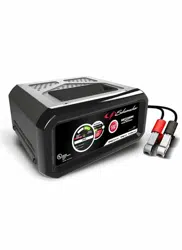Loading ...
Loading ...
Loading ...

• 7 •
12. MAINTENANCE AND CARE
A minimal amount of care can keep your
battery charger working properly for years.
• Clean the clamps each time you are
nished charging. Wipe off any battery
uid that may have come in contact with
the clamps to prevent corrosion.
• Occasionally cleaning the case of the
charger with a soft cloth will keep the
nish shiny and help prevent corrosion.
• Coil the input and output cords neatly
when storing the charger. This will help
prevent accidental damage to the cords
and charger.
• Store the charger unplugged from the AC
power outlet in an upright position.
• Store inside, in a cool, dry place. Do not
store the clamps clipped together, on the
handle, on or around metal, or clipped to
the cables.
13. TROUBLESHOOTING
PROBLEM POSSIBLE CAUSE SOLUTION
Battery clamps do not
spark when touched
together.
The charger is equipped
with an auto-start feature.
It will not supply current to
the battery clamps until a
battery is properly connected.
The clamps will not spark if
touched together.
No problem; this is a normal
condition.
The LED does not
light when charger is
properly connected.
AC outlet is dead.
Poor electrical connection.
Check for open fuse or circuit
breaker supplying AC outlet.
Check power cord and extension
cord for loose tting plug.
Short or no start cycle
when cranking engine.
No power at receptacle.
AC cord and/or extension cord
is loose.
The clamps are not making a
good connection.
Failure to wait 3 minutes (180
seconds) between cranks.
The battery may be severely
discharged.
The battery is drawing more
than the Engine Start Rate.
The charger may be
overheated.
Check for open fuse or circuit
breaker supplying AC outlet.
Check power cord and extension
cord for loose tting plug.
Check for poor connection at
battery and frame.
Wait 3 minutes of rest time before
the next crank, to allow the battery
and charger to cool down.
On a severely discharged battery,
use the 10A BOOST setting for few
minutes, to help assist in cranking.
Crank time varies with the amount
of current drawn. If cranking draws
more than the Engine Start Rate,
crank time may be less than 3
seconds.
The thermal protector may have
tripped and needs a little longer to
close. Make sure the charger vents
are not blocked. Wait and try again.
Loading ...
Loading ...
Loading ...
